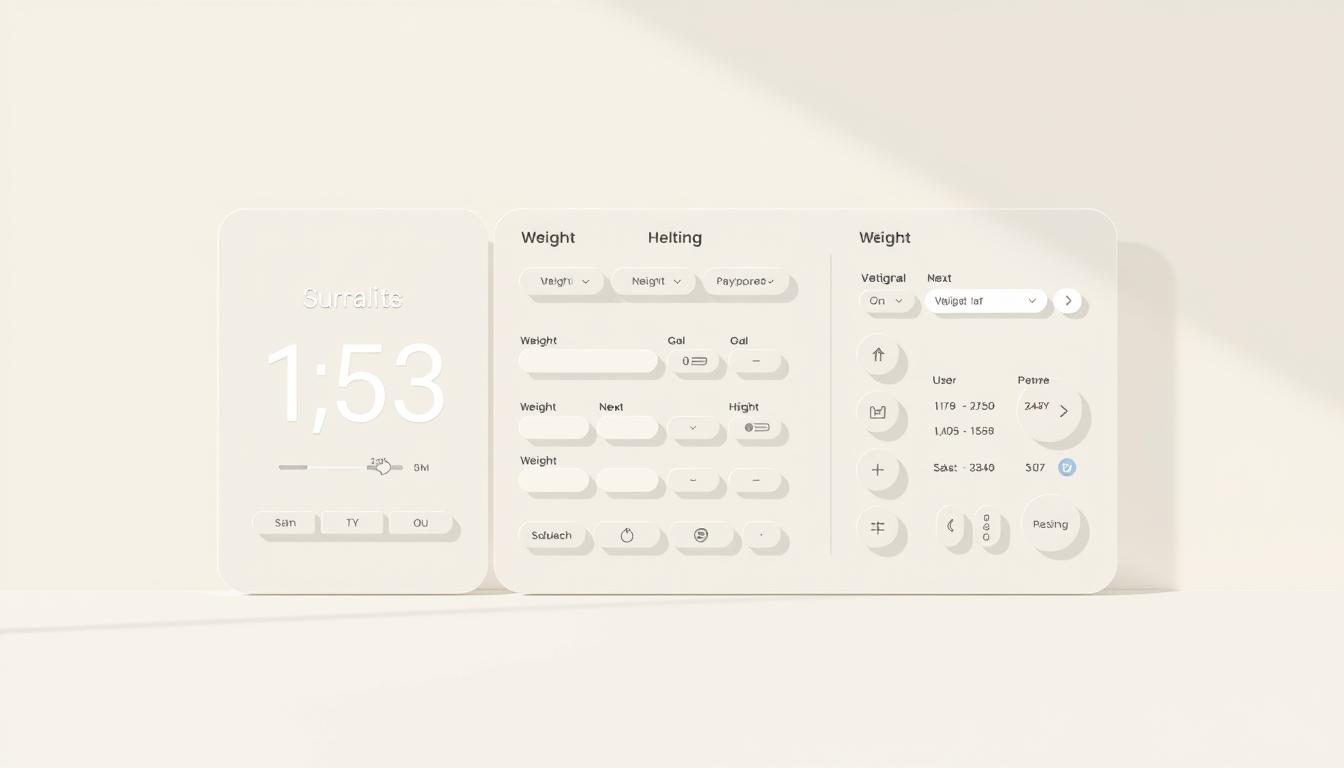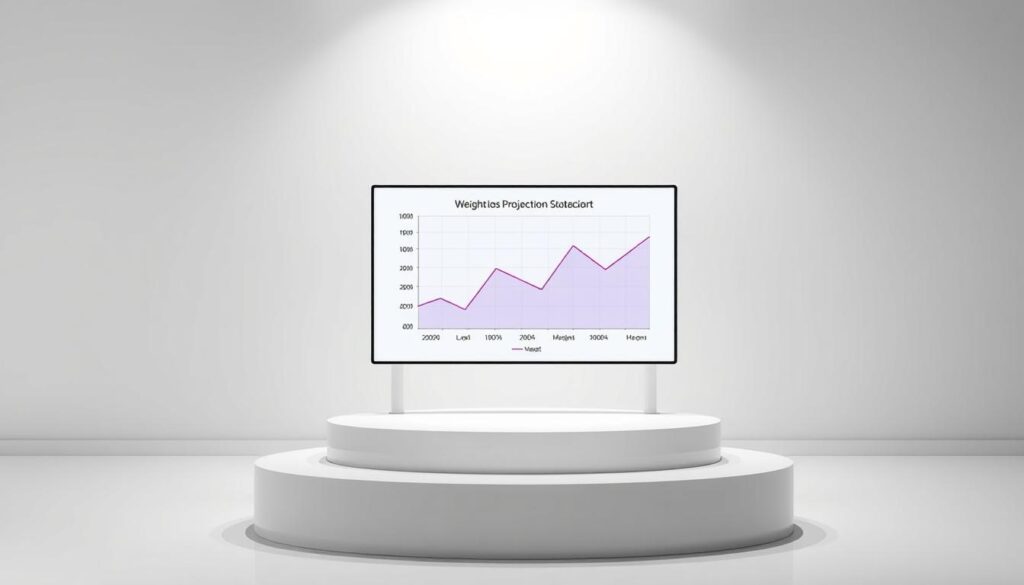Achieving a healthy weight is a journey that requires patience, dedication, and a well-planned strategy. As Michelle Obama once said, “You can’t just wish for it, you have to make it happen.” This mindset is crucial when it comes to weight loss and adopting a sustainable lifestyle.
Our weight loss goal calculator is designed to help you set realistic targets based on your individual needs and calories intake. By analyzing personal metrics, activity levels, and metabolic factors, we create a customized plan that balances nutrition with your weight loss goals.
We emphasize the importance of setting achievable goals and timeframes for sustainable weight loss, rather than pursuing rapid, unhealthy weight reduction.
Key Takeaways
- Personalized weight loss planning based on individual factors
- Customized weight loss plans that balance nutrition and calories intake
- Realistic weight loss targets based on user metrics and activity levels
- Sustainable weight loss strategies rather than rapid weight reduction
- Understanding daily caloric needs for effective weight management
Understanding the Science Behind Weight Loss
The process of losing weight involves more than just cutting calories; it’s about comprehending the body’s complex mechanisms. When we embark on a weight loss journey, we’re not just losing fat; we’re also losing some lean tissue, including muscle, bones, and water.
How Your Body Loses Weight
Lean mass consists of everything that’s not fat, including muscle, bones, organs, ligaments, tendons, and other tissues. When you lose weight, your total daily energy expenditure (TDEE) changes. This change includes a reduction in basal metabolic rate (BMR) and a decreased energy cost of physical activity. As a result, the body’s energy requirements decrease, making it more challenging to continue losing weight over time.
The Myth of 3,500 Calories Per Pound
A common misconception is that cutting 3,500 calories always equals one pound of weight loss. However, this oversimplified formula fails to account for the body’s complex adaptive mechanisms, such as metabolic adaptation and changes in body composition. These factors complicate the calories-in, calories-out equation, making it difficult to predict weight loss accurately.
To better understand weight loss, let’s examine the changes that occur in the body:
| Component | Change During Weight Loss | Impact on Weight Loss |
|---|---|---|
| Lean Mass | Decreases | Reduces metabolic rate |
| Fat Mass | Decreases | Reduces overall weight |
| Basal Metabolic Rate (BMR) | Decreases | Makes it harder to lose weight |
Our calculator uses more sophisticated mathematical models that account for these factors, providing a more realistic projection of weight loss. By understanding the science behind weight loss, we can better navigate the challenges of achieving and maintaining a healthy weight.
How Our Weight Loss Goal Calculator by Date Works
Setting a realistic weight loss goal is crucial, and our date-based calculator helps you do just that. By understanding the science behind weight loss and using a reliable mathematical model, our tool provides a personalized plan tailored to your needs and activity level.
The Mathematical Model Behind the Calculator
Our weight loss calculator utilizes the mathematical body model equations developed by Kevin Dennis Hall, Ph.D., and his team of researchers at the National Institute of Diabetes and Digestive Kidney Diseases of the National Institute of Health. This model accurately determines an individual’s energy requirements for weight loss and management by accounting for complex body dynamics, including adaptations that oppose weight change and changes in glycogen and extracellular fluid levels.
Benefits of Using a Date-Based Approach
Using a date-based approach with our calculator offers several benefits. By setting a target date, you enhance your motivation and accountability throughout your weight loss journey. Here are some key advantages:
- Creating structured, realistic plans that prevent crash dieting
- Adjusting daily recommendations based on the timeframe for safe and sustainable progress
- Tracking progress and making necessary adjustments with a clear timeline
- Developing long-term habits rather than relying on short-term fixes
By focusing on a specific goal and date, you can achieve a more sustainable weight loss. Our calculator helps you stay on track, ensuring that your weight loss journey is both effective and maintainable.
Essential Inputs for Accurate Weight Loss Projection
Our weight loss goal calculator by date relies on specific personal data to provide an accurate projection. To get started, you’ll need to input some basic information about yourself.
Personal Metrics: Age, Sex, Height, and Weight
The first set of inputs includes your age, sex, height, and current weight. These metrics are crucial because they help us estimate your basal metabolic rate (BMR), which is a foundational element in calculating your daily caloric needs. For instance, your height and weight are used to determine your body mass index (BMI), a useful indicator of whether you’re at a healthy weight.
Activity Level Assessment
Next, you’ll need to assess your physical activity level. This can range from 1.4 (little activity) to 2.3 (very active). If you’re unsure, you can start with the default value of 1.4, representing the worst-case scenario. Understanding your physical activity level helps us adjust your caloric needs based on how active you are.
Setting Realistic Timeframes
Finally, setting a realistic timeframe for your weight loss goal is vital. This involves entering a start date and a target date for achieving your goal weight. We discuss the importance of setting realistic timeframes and provide guidelines based on the amount of weight you aim to lose.
| Activity Level | Description | Multiplier |
|---|---|---|
| Little activity | Sedentary lifestyle | 1.4 |
| Moderately active | Light exercise/sports 1-3 days/week | 1.7 |
| Very active | Heavy exercise/sports 6-7 days a week | 2.3 |
As noted by health experts, “Crash diets and overly ambitious weight loss goals can lead to disappointment and health risks.” Therefore, it’s essential to set achievable milestones.
- Determine appropriate time horizons based on the amount of weight to lose.
- Understand the health risks associated with trying to lose weight too quickly.
- Consider factors like starting weight, age, and physical activity level when setting timeframes.
Calculating Your Daily Caloric Needs
Calculating your daily caloric needs is a critical component of a successful weight loss strategy. To lose weight effectively, you must understand how many calories your body requires to function and how many you need to consume to achieve your weight loss goals.
Understanding Basal Metabolic Rate (BMR)
Your Basal Metabolic Rate (BMR) is the number of calories your body needs to perform basic life-sustaining functions like breathing, circulation, cell production, nutrient processing, and temperature regulation. BMR is a significant component of your daily caloric needs, typically accounting for 60-75% of your total energy expenditure.
For instance, a person with a high BMR will burn more calories at rest than someone with a lower BMR. Factors such as age, sex, weight, and height influence your BMR. Understanding your BMR is essential for determining your overall daily caloric requirements.
Total Daily Energy Expenditure (TDEE)
Total Daily Energy Expenditure (TDEE) represents the total number of calories your body burns each day, including your BMR and the energy expended during physical activity. TDEE is a crucial metric for determining your daily caloric needs, as it provides a comprehensive picture of your energy expenditure.
To calculate your TDEE, you need to consider your activity level. The calculator uses your activity level assessment to adjust your daily caloric needs accordingly. For example, someone with a sedentary lifestyle will have a lower TDEE compared to someone who is highly active.
| Activity Level | TDEE Multiplier |
|---|---|
| Sedentary | 1.2 |
| Lightly Active | 1.375 |
| Moderately Active | 1.55 |
| Very Active | 1.725 |
| Extra Active | 1.9 |
Creating a Safe Caloric Deficit
A caloric deficit occurs when you consume fewer calories than your body burns, resulting in weight loss. To create a safe and sustainable caloric deficit, it’s essential to understand that excessively low caloric intake can be counterproductive. Our weight loss calculator ensures that your daily caloric intake does not fall below 1,200 calories for women and 1,500 calories for men, as recommended by nutrition therapists.
For example, if the calculator determines that you need to consume fewer than 1,000 calories to reach your goal weight by your target date, it will adjust your target date to ensure you meet the minimum recommended caloric intake. This approach helps prevent nutritional deficiencies and promotes a more sustainable weight loss journey.
As noted by a registered dietitian, “A moderate caloric deficit is more effective long-term than severe restriction. It’s about making sustainable lifestyle changes rather than following fad diets.”
“A caloric deficit is essential for weight loss, but it should be done safely and sustainably.”
To maintain a safe caloric deficit, consider the following tips:
- Eat nutrient-dense foods to satisfy your hunger and nutritional needs.
- Incorporate physical activity to enhance your TDEE.
- Monitor your progress and adjust your caloric intake as needed.
Optimizing Your Macronutrient Balance
Understanding and optimizing your macronutrient balance is key to a successful weight loss journey. Our weight loss goal calculator not only helps you determine your daily caloric needs but also calculates your macronutrient requirements in grams for a balanced diet.
The calculator provides macronutrient distributions for various diet types, including balanced, low-fat, low-carb, and high-protein diets, ensuring that each macronutrient’s percentage falls within the acceptable range as per the Food and Nutrition Board of the Institutes of Medicine (IOM) dietary guidelines.
Protein Requirements for Preserving Muscle Mass
Protein is crucial for preserving muscle mass during weight loss. The recommended protein intake varies based on factors such as age, sex, weight, and activity level. Generally, a higher protein intake is recommended for individuals aiming to lose weight while preserving muscle mass.
Preserving muscle mass is essential for maintaining metabolism and overall health. Our calculator ensures that your protein intake is adequate to support your muscle mass during the weight loss process.
Healthy Fats and Their Role in Weight Loss
Healthy fats play a vital role in overall health and can support weight loss efforts. They are essential for hormone production, absorption of vitamins, and providing a feeling of fullness.
The IOM recommends that 20%-35% of your daily calories come from fat. Our calculator will provide a fat intake recommendation within this range, tailored to your specific weight loss goals and dietary preferences.
Carbohydrates: Finding the Right Balance
Carbohydrates are a primary source of energy for the body and are crucial for exercise performance and overall health. The quality and quantity of carbohydrates consumed can significantly impact weight management.
| Carbohydrate Type | Effect on Blood Sugar | Impact on Weight Management |
|---|---|---|
| Simple Carbohydrates | Rapid increase | Can hinder weight loss |
| Complex Carbohydrates | Gradual increase | Supports weight loss |
Our calculator determines your carbohydrate intake based on your activity level and goals, ensuring that you stay within the recommended 45%-65% of daily calories from carbohydrates. By choosing high-quality carbohydrate sources, you can support your weight loss journey effectively.
Practical Strategies to Reach Your Weight Loss Goal
Effective weight loss is not just about short-term changes, but about adopting long-term healthy habits. To achieve your weight loss goal, it’s crucial to implement practical and sustainable strategies that encompass dietary changes, physical activity, and regular progress tracking.
Developing Sustainable Eating Habits
Developing sustainable eating habits is fundamental to successful weight loss. This involves focusing on nutrient-dense foods, such as fruits, vegetables, lean proteins, and whole grains. It’s also important to practice mindful eating and control portion sizes to maintain a healthy caloric intake. By making these habits a part of your daily routine, you can create a sustainable dietary plan that supports your weight loss goals.
A key aspect of sustainable eating is planning your meals in advance. This helps in avoiding last-minute, often unhealthy, food choices. Meal planning also allows you to ensure you’re getting a balanced diet that meets your nutritional needs. Incorporating a variety of foods into your meals can help keep your diet interesting and prevent boredom.
Incorporating Physical Activity Effectively
Physical activity plays a vital role in weight loss and overall health. It’s not just about exercising; it’s about finding activities you enjoy and can maintain in the long term. A mix of cardiovascular exercises, such as walking or cycling, and strength training can help you burn calories and build muscle. Aim for at least 150 minutes of moderate-intensity exercise or 75 minutes of vigorous-intensity exercise per week.
In addition to structured exercise, incorporating more physical activity into your daily routine can make a significant difference. This can include taking the stairs instead of the elevator, walking to work, or doing household chores. Every bit counts, and these small changes can add up over time.
Tracking Progress and Making Adjustments
Tracking your progress is essential to understanding how your body is responding to your weight loss efforts. This can involve monitoring your weight, taking body measurements, tracking your food intake, and assessing your physical activity levels. By regularly tracking these metrics, you can identify patterns and make informed adjustments to your diet and exercise plan as needed.
- Regularly weigh yourself to track weight changes.
- Take body measurements to monitor changes in body composition.
- Use a food diary or an app to track your daily food intake and physical activity.
- Adjust your caloric intake and exercise routine based on your progress.
Beyond the Calculator: Maintaining Your Results Long-Term
Achieving your weight loss goal is just the beginning of your journey to a healthier lifestyle. Losing weight is not just about diet and exercise; it’s about making a complete lifestyle change. To maintain your results, you need to transition from active weight loss to long-term weight maintenance.
During weight loss, your metabolism adapts, affecting your long-term maintenance strategies. To maintain your weight, you’ll need to adjust your caloric intake and physical activity levels. Our weight loss calculator can help you establish maintenance calorie targets after reaching your goal weight.
Maintaining weight loss also involves psychological aspects, such as identity shifts and habit formation. It’s essential to integrate healthy habits into a sustainable lifestyle that supports long-term weight management and overall health. Ongoing monitoring and making small adjustments before small gains become large ones are crucial for maintaining your results.
To stay on track, you’ll need to maintain motivation and focus after the initial excitement of weight loss has faded. By making sustainable lifestyle changes, you can achieve long-term success and enjoy a healthier, more balanced life. With the right mindset and strategies, you can maintain your weight loss results and improve your overall health and wellbeing.



